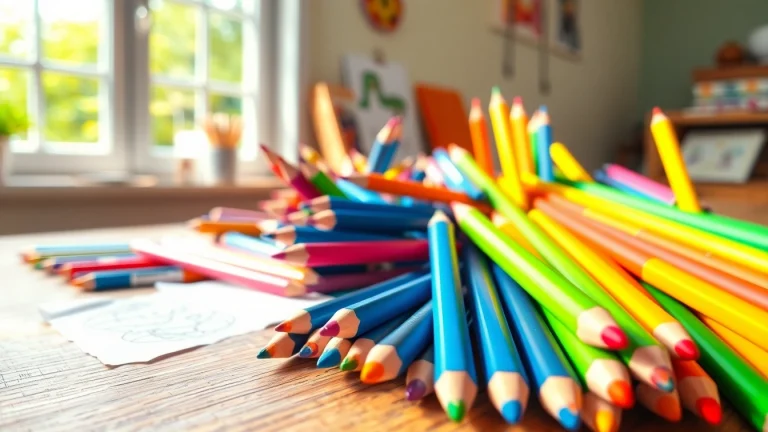
Engaging Children with Color: The Benefits of Kids Colouring Pencils
The Importance of Kids Colouring Pencils in Child Development
Colouring is not just a fun pastime for children; it is a crucial activity that supports various aspects of their development. Kids colouring pencils, specifically, play a significant role in aiding children as they grow and learn. From enhancing their motor skills to deepening their understanding of colours and creativity, these art supplies are invaluable tools in childhood education. By incorporating kids colouring pencils into their daily routine, parents and caregivers can help children engage in productive learning and expressive activities that contribute to their overall development.
Understanding Motor Skills Development
One of the first areas impacted by colouring is a child’s fine motor skills. When children grasp a pencil, they are not only learning how to hold an object but also exercising the small muscles in their hands and fingers. This development of fine motor skills is essential as it lays the groundwork for other skills such as writing, typing, and even daily tasks like buttoning their shirts or tying shoelaces.
Research indicates that activities involving precise hand movements, like colouring, help improve dexterity in young children. Moreover, as they experiment with different pressures and angles while colouring, they build hand-eye coordination, which is critical for their future academic tasks. Through consistent practice, children gain greater control over their writing instruments, which seamlessly translates into their ability to write legibly later on.
Enhancing Creative Expression
Colouring is a superb outlet for creative expression. Kids can explore their imaginations as they choose colours and develop their artistic styles. This freedom fosters confidence and a sense of ownership over their work. When children create art, they learn to make decisions autonomously, which is a crucial part of their social and emotional development.
Encouraging children to express themselves through colour can also help in explaining their feelings or experiences they may not yet have the words for. Artistic expression enables them to depict their thoughts visually, assisting not only in emotional development but also in cognitive growth as they contemplate their choices and the meaning behind their creations.
Color Recognition and Learning
Colouring introduces children to a rich spectrum of colours. When they engage in this activity, they begin to distinguish between various shades and hues, which is fundamental in both art and everyday life. Understanding colour, including mixing and matching different shades, enhances their cognitive abilities and lays a solid foundation for subjects such as math, science, and literacy.
In educational settings, activities that incorporate colour not only aid in vocabulary expansion but also create situations where children must learn about properties, categories, and relationships. Moreover, it can be tied in with subjects such as biology when discussing nature, or even culture when it comes to traditional art from different regions.
Types of Kids Colouring Pencils Available
Wax vs. Oil-Based Pencils
When selecting kids colouring pencils, you’ll primarily find two types on the market: wax-based and oil-based pencils. Each type has its features and benefits.
Wax-based pencils are typically more affordable, accessible, and easier for young children to use. They have a softer texture, making it easier to lay down layers of colour and blend. This quality makes wax pencils a favourite choice for preschoolers or early primary school children who are still developing their skills.
On the other hand, oil-based pencils are more durable and often provide richer, more vivid colours. They tend to be favored by older children or those who are more committed to art, as they work well for finer details and shading. While they can be slightly more challenging to work with, older kids often appreciate the depth of colour and the professional finish they can achieve.
Eco-Friendly Options: What to Look For
With increasing awareness of environmental issues, many brands are producing eco-friendly kids colouring pencils. Parents today are looking for sustainable options that are free from harsh chemicals and made with recycled materials.
When seeking eco-friendly pencils, consider those made from sustainably sourced wood or that utilize vegetable-based dyes. Look for certifications or labels that indicate the product meets environmental standards. These options not only safeguard children’s health but also teach kids the importance of environmental responsibility from an early age.
Choosing the Right Size and Grip
Choosing the right pencil size and grip is essential for supporting the needs of individual children. Younger children typically require shorter pencils that are easier for their small hands to grasp. Pencils with triangular grips to help promote a proper hold are also beneficial as they can encourage the correct finger placement.
As children grow and develop, they may transition to longer pencils with a more classic cylindrical shape. It’s also worthwhile to explore pencils that come with rubber grips or ergonomic designs, which can help prevent fatigue during extended colouring sessions. Ultimately, selecting the right tools fosters greater enjoyment and success in their artistic endeavours.
Creative Ways to Use Kids Colouring Pencils
Art Projects Beyond the Page
While colouring on paper is a classic method, there are countless creative projects that can utilize kids colouring pencils in innovative ways. For instance, kids can use them to decorate items such as T-shirts, tote bags, or even canvas shoes. Using fabric markers in tandem with the pencils can create vibrant, long-lasting designs that allow their personalities to shine.
Another exciting venture is creating custom greeting cards. Children can draw and colour designs for birthdays, holidays, or special occasions, making personal touches that recipients will treasure. These projects not only encourage creative expression but also instill a sense of pride in their craftsmanship.
Incorporating Colouring into Learning Activities
Colouring can seamlessly integrate into various learning activities, turning any lesson into a vibrant experience. For example, when learning about dinosaurs, kids can colour different species, enhancing retention and engagement. Colouring can also be tied to language skills by having children illustrate a short story and then present it to others.
In math, encourage children to use pencils to colour in sections of geometry shapes, visually representing fractions or combinations of shapes that make patterns. This method engages visual learners and makes abstract concepts tangible, creating a dynamic learning atmosphere.
Fun Group Activities for Kids
Group colouring activities can serve as excellent socialization tools for children. Whether through organized team events or informal gatherings, these activities promote collaboration and shared art experiences. For instance, schools can host colouring competitions or collaborative murals where each child contributes a section, fostering teamwork and boosting project comprehension.
At home, parents can set up a colouring party where friends come together to create art projects. This can involve themed activities—such as a nature-inspired day where kids colour different flora and fauna—and allow them to share ideas, techniques, and outcomes with their peers, further enhancing their social skills.
Tips for Parents: Selecting Quality Kids Colouring Pencils
What to Consider for Safety and Non-Toxicity
When selecting kids colouring pencils, the safety and non-toxicity of materials is of utmost importance. Opt for products clearly labeled as non-toxic and free from harmful chemicals like lead or phthalates. Testing organizations such as ASTM International or the American Society for Testing and Materials certify products that meet health and safety standards, ensuring that what your child uses is safe for their health.
Understanding Grade and Quality Levels
Kids colouring pencils vary in quality and grade, which can be a determining factor in the buying decision. For beginners, a basic grade pencil will suffice, allowing them to explore their artistic sides without frustration. However, as children develop their skills and demand more from their tools, it might be beneficial to upgrade to higher-quality pencils that offer improved colour payoff, blending ability, and longevity.
In general, professional-grade pencils provide richer pigments and smoother usage, making it easier for artists to achieve desired results. Gather feedback from children about their preferences during each stage of development, which can guide your purchasing choices.
Pricing: Value vs. Cost
When investing in kids colouring pencils, it’s essential to weigh the value versus cost. While cheaper options may save money upfront, they might not deliver the same satisfaction as more premium choices. Higher-quality pencils may be more expensive, but they can maintain their shape longer, apply more evenly, and provide a superior overall experience.
Furthermore, consider the longevity of the product. Children may use a pencil for several months, so the upfront cost should be viewed as an investment in their creative pursuits. Look for sets that offer variety at a reasonable price, and don’t hesitate to consult reviews or product recommendations from other parents to ensure you are making the right decision.
Inspiration for Kids: Colouring with Purpose
Themed Colouring Books Worth Exploring
Themed colouring books are an excellent source of inspiration for children. Consider investing in ones that focus on themes that resonate with your child’s interests, whether that be animals, space exploration, or favourite characters from books and movies. These books engage children creatively while promoting their awareness of a subject.
For instance, nature-based colouring books may provide a backdrop for educational conversations about the environment, while themed books that focus on historical events can spark discussions about history. Additionally, themed creative activities can enhance the learning experience, bridging art and educational content in fun and stimulating ways.
Utilizing Online Resources for Ideas
The internet abounds with creative resources that provide activities, printables, and digital colouring experiences. Parents can find free templates online to print or download, enabling endless possibilities simply with a few clicks. Websites dedicated to educational resources often have comprehensive colouring activities connected to lesson plans, learning goals, or seasonal themes.
Moreover, online platforms boasting user-generated content allow children to share their work, providing a space for encouragement and fostering a sense of community. Access to an expansive range of resources can keep children engaged and can provide parents with fresh ideas to motivate their budding artists.
Hosting Colouring Contests to Encourage Participation
Finally, hosting colouring contests can spark enthusiasm and participation among young artists. Whether at school, community centres, or at home, contests can simplify the process of creative expression while promoting friendly competition. Prizes can include art supplies, recognition, or even a feature in a local newsletter or social media page.
These events encourage children to push their boundaries and express themselves freely while also developing their skills under pressure. Organizing these contests is not only rewarding for children but can create a community spirit, fostering friendships and support among peers.


